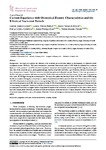Current experience with obstetrical events: characteristics and the effects of nocturnal periods

View/
Use this link to cite
http://hdl.handle.net/2183/36554
Except where otherwise noted, this item's license is described as Creative Commons Attribution 4.0 International Licence (CC-BY 4.0)
Collections
- Investigación (FFISIO) [481]
Metadata
Show full item recordTitle
Current experience with obstetrical events: characteristics and the effects of nocturnal periodsAuthor(s)
Date
2024-03-25Citation
Blanco-López S, Peteiro-Mahía L, Navas-Arrebola R, López-Castiñeira N, Pértega-Díaz S, Seoane-Pillado T. Current experience with obstetrical events: characteristics and the effects of nocturnal periods. Clin Exp Obtet Gynecol. 2024;51(4):80.
Abstract
[Abstract] Background: The object is to analyze the influence of the nocturnal period and lunar phases on the frequency of obstetrical events in pregnant women. Methods: This was a retrospective, transversal observational study of 1409 births in a hospital from northwest Spain (α = 0.05; precision = ±2.65%). A review of patients’ clinical records was performed recording the following data: labor onset type, date of last menstrual period, parity, gestational age, duration of pre-labor and labor, type of delivery, the hour, work shift, and lunar phase pattern of events. Statistical evaluation included descriptive and inferential analysis. Results: Labor was spontaneous in 58.3% of all cases; spontaneous deliveries accounted for 54.2% of the total and 19.2% were instrumental. In the cases of spontaneous labor onset, 48.5% began during the nocturnal period. The early labor phase was less than 6 hours in 62.7% of cases (44.8% during the full moon phase). During the nocturnal period, rupture of membranes and dilation periods of less than 3 hours were more common, with 32% of spontaneous membrane rupture occurring during a full moon. A significant dependence was observed between the labor type and nocturnal period, as 40.8% of all spontaneous births, 36.2% of instrumental births and 46.9% of emergency cesarean sections occurred during the night shift. Furthermore, 66.3% of precipitous deliveries (<3 hours) took place during this period. Conclusions: The nocturnal period is related to a higher number of spontaneous rupture of the membranes, non-intervention in the onset of labor, shorter early labor phases, faster deliveries, spontaneous births and emergency caesarean sections. A higher frequency of spontaneous rupture of the membranes, a full labor, early labor phases of less than 3 hours and emergency caesarean sections was observed during full moon phases.
Keywords
Pregnancy outcomes
Obstetrical deliveries
Circadian rhythm
Obstetrical deliveries
Circadian rhythm
Editor version
Rights
Creative Commons Attribution 4.0 International Licence (CC-BY 4.0)
ISSN
0390-6663






